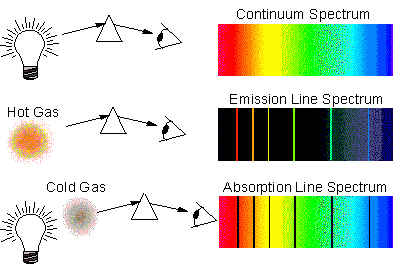Stellar Spectra
| H. E. Smith | Spring 2007 |

| Physics 5 - Lecture Summary #9 Stellar Spectra |

We may consider three principal types of spectra which appear when the light from an object is broken up into its component wavelengths or "dispersed":

An absorption spectrum is produced when a continuum passes through "cooler" gas. Photons of the appropriate energies are absorbed by the atoms in the gas. Although the photons may be re-emitted, they are effectively removed from the beam of light, resulting in a dark or absorption feature. The atmospheres of stars act as a cooler blanket around the hotter interior of a star so that typical stellar spectra are absorption spectra.

The systematic classification of stars in terms of absorption features and the understanding that such spectral classification is essentially a sequence in atmospheric temperature was due to Annie J. Cannon at Harvard.
| Stellar Spectral Classification | |||||||
|---|---|---|---|---|---|---|---|
| Spectral Type |
Atmospheric Temperature (K) |
Hydrogen (Balmer) Features |
Other Features | M/M |
R/R |
L/L |
Main Sequence Lifetime |
| O | >33,000 K | weak | Ionized Helium (He+) features sometimes in emission Strong UV continuum | 20-60 | 9-15 | 90,000-800,000 | 10-1 Myr |
| B | 10,500-30,000 K | medium | Neutral He absorption | 3-18 | 3.0-8.4 | 95-52,000 | 400-11 Myr |
| A | 7,500-10,000 K | strong | H features maximum at A0 Some features of heavy elements, eg Ca+ |
2.0-3.0 | 1.7-2.7 | 8-55 | 3 Gyr - 440 Myr |
| F | 6,000-7,200 K | medium | 1.1-1.6 | 1.2-1.6 | 2.0-6.5 | 7-3 Gy | |
| G | 5,500-6,000 K | weak | Ca+ H&K, Na "D" Sun is G2V |
0.9-1.05 | 0.85-1.1 | 0.66-1.5 | 15-8 Gy |
| K | 4,000-5,250 K | v. weak | Ca+, Fe, Strong molecules, eg CH, CN |
0.6-0.8 | 0.65-0.80 | 0.10-0.42 | 17 Gy |
| M | 2,600-3,850 K | v. weak | Molecules, eg TiO Very red continuum |
0.1-0.5 | 0.17-0.63 | 0.001-0.08 | 56 Gy |
| L | 1300-2,500K | Metal hydride molecular bands (CrH & FeH); neutral metal lines | ~ 0.08 | ||||
| T | < 1300 | Methane bands | < 0.08 |
Click on the spectral type above to see spectra of the appropriate type or click here to see Spectral Types O - G and here for Spectral Types G - M
Click here for a selection of Spectral Sequence mnemonics
The temperature of the stellar photosphere determines the rate and severity of collisions between molecules, atoms and ions which in turn determines:
Among the other things that we may determine from the absorption spectrum are: density, chemical composition, magnetic field strength, and radial velocity. These are all secondary effects compared to temperature.

![]() The Hertzsprung-Russell Diagram
The Hertzsprung-Russell Diagram
![]() The Sun
The Sun
![]() Physics 5 Lectures
Physics 5 Lectures
![]() Physics 5 Home
Physics 5 Home
Conducted by Gene Smith, CASS/UCSD.
Comments?
You may send email to hsmith@ucsd.edu
Prof. H. E. (Gene) Smith
CASS 0424 UCSD
9500 Gilman Drive
La Jolla, CA 92093-0424
Last updated: 28 Jan 2000